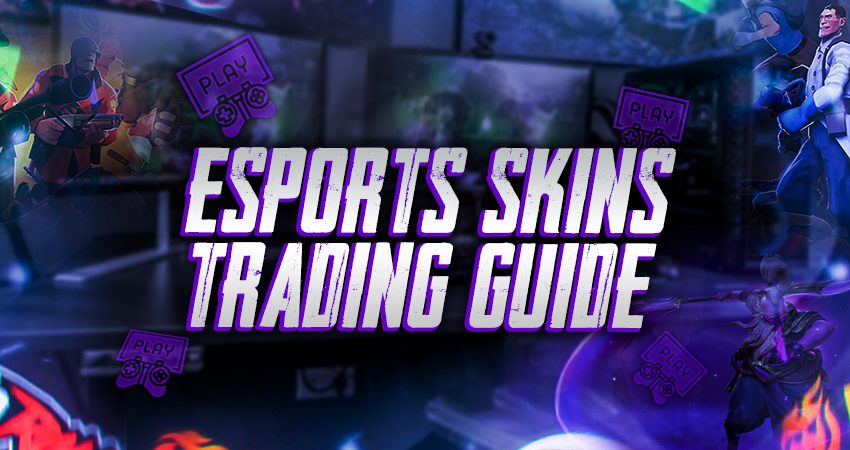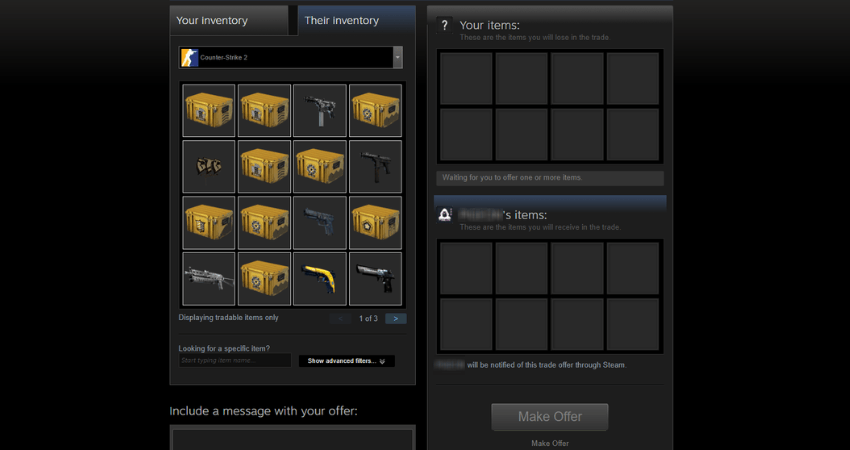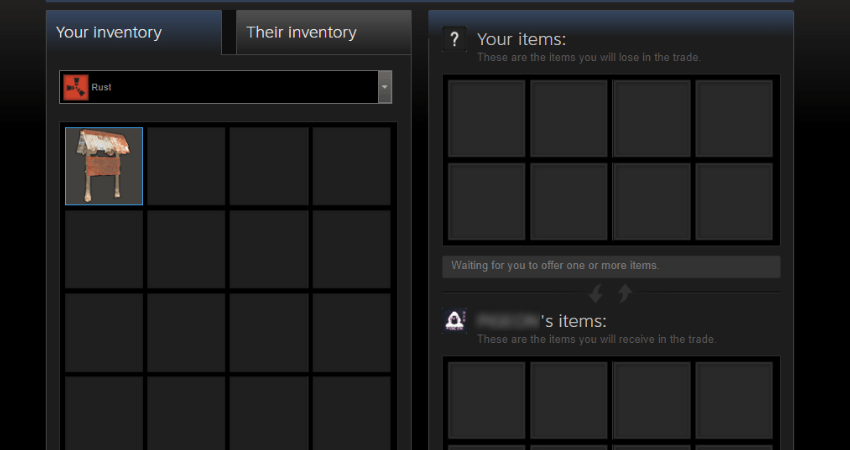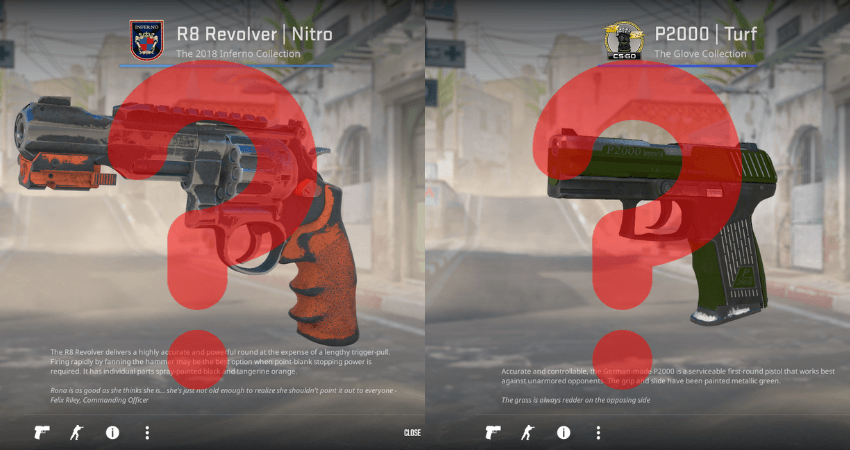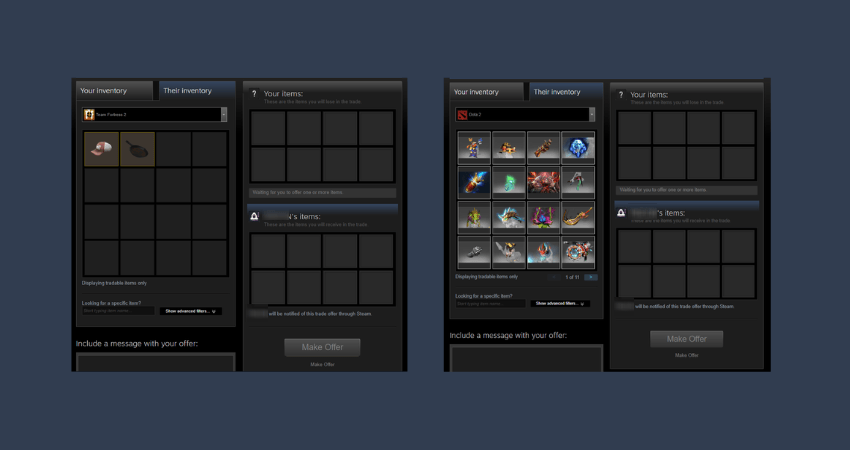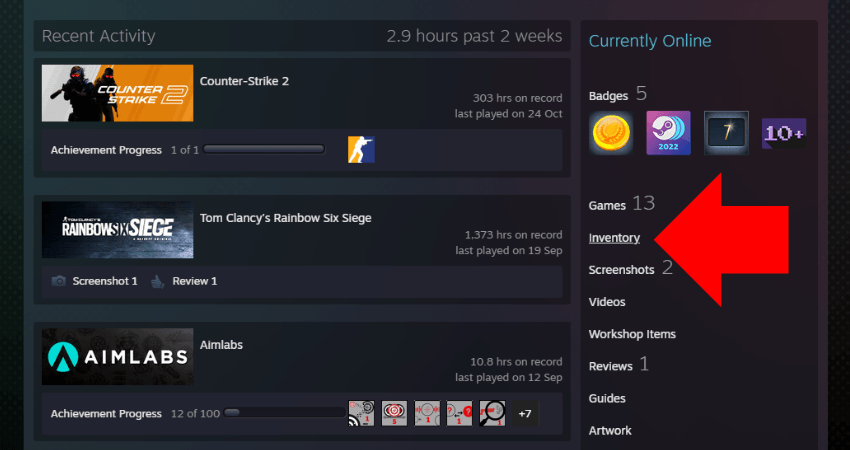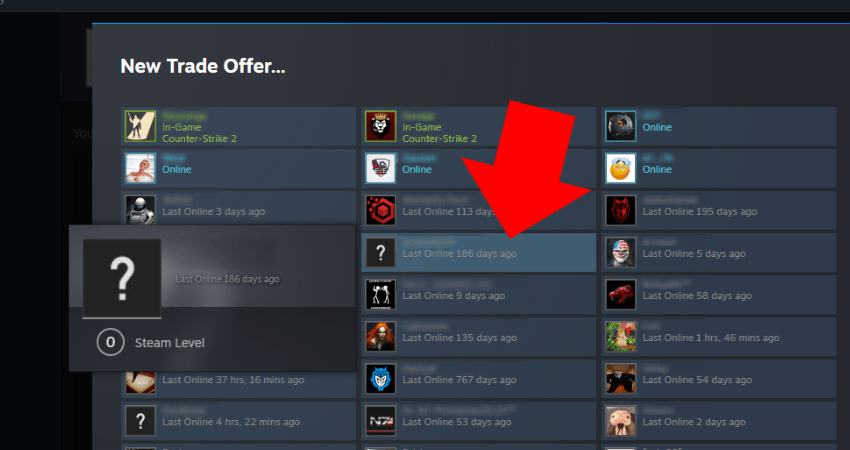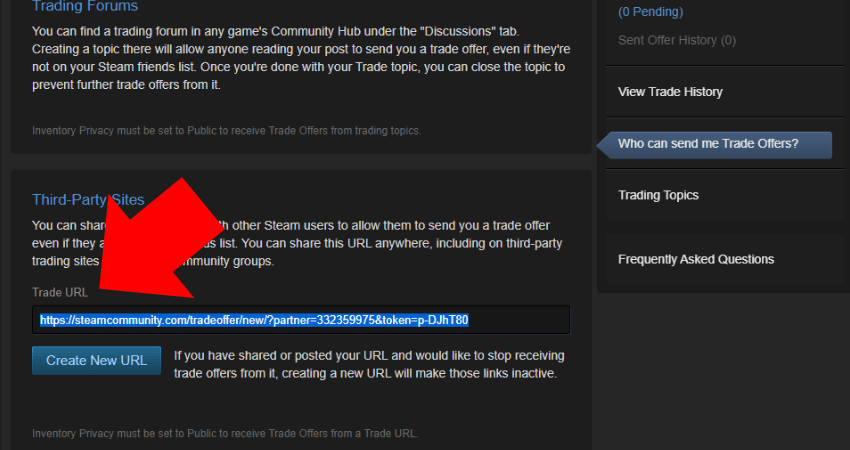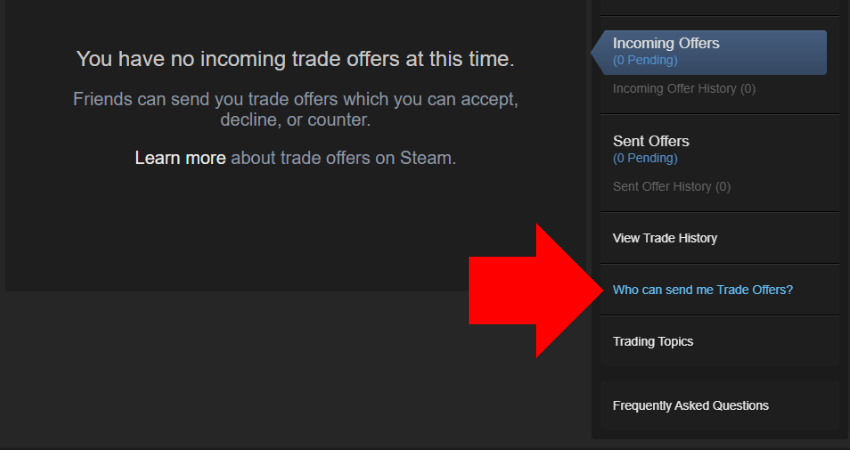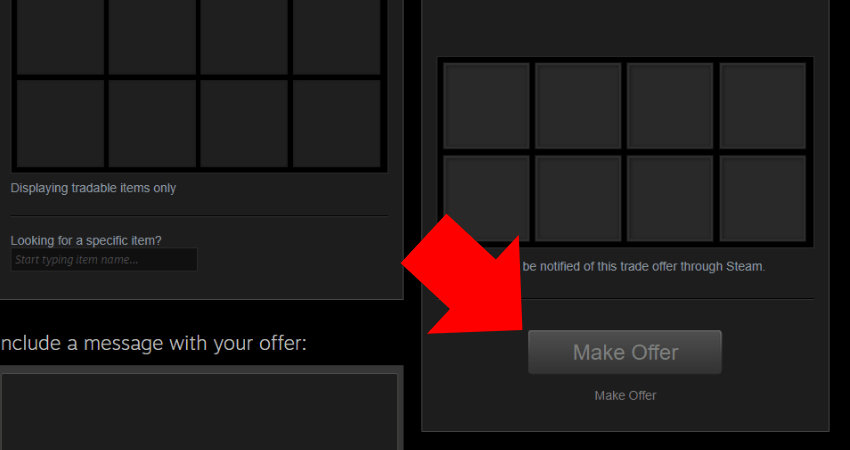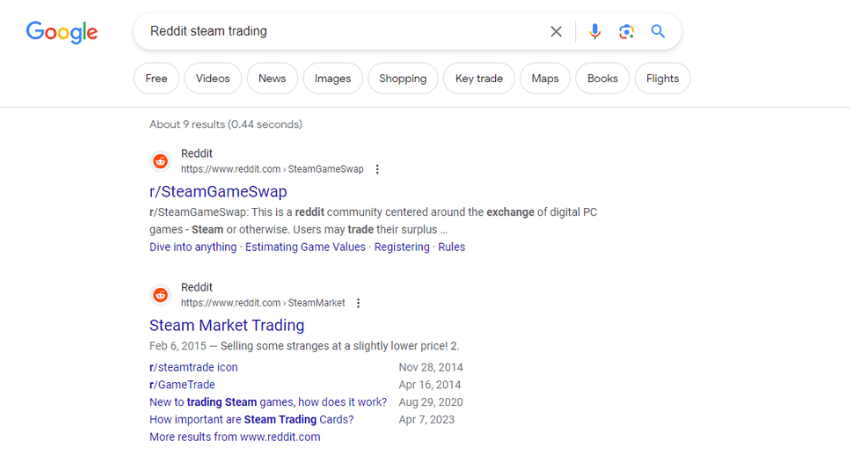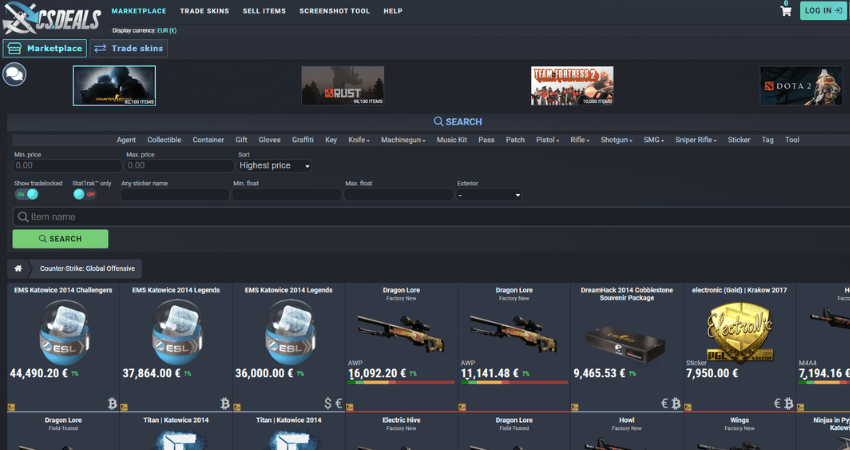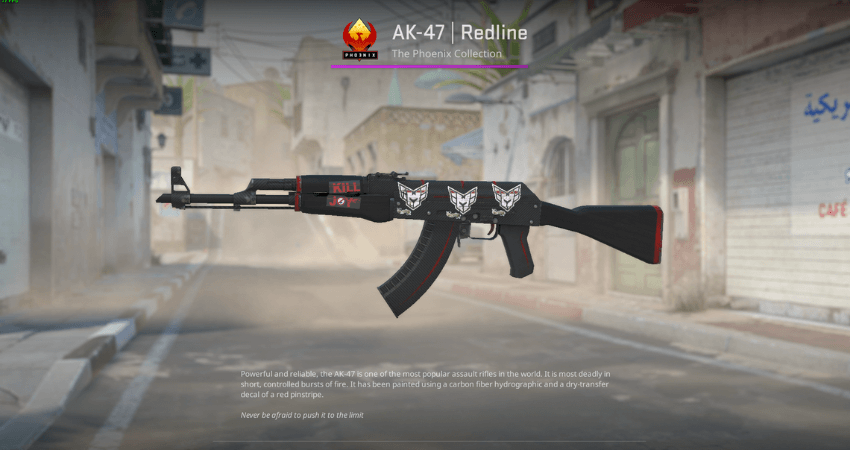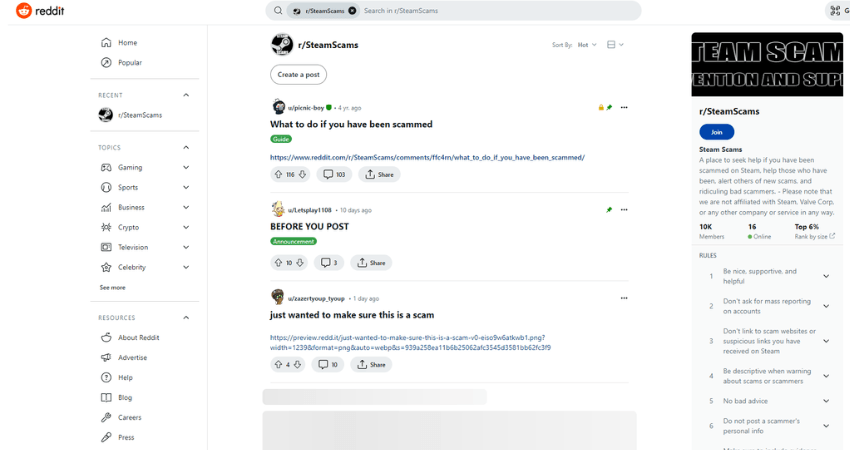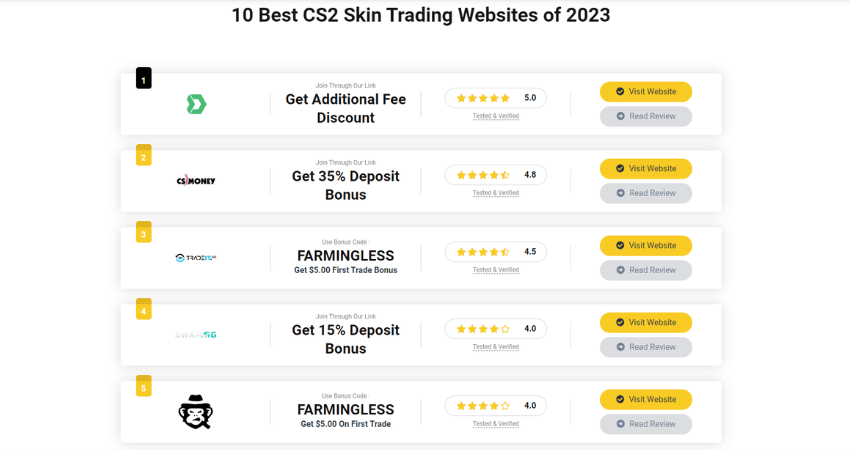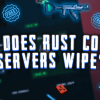The gaming world has multiple ecosystems where people with similar interests engage with each other, the most popular of which is the eSports skins trading scene. However, getting into eSports skins trading can seem quite complicated. To help you with that, here is a complete eSports skins trading guide. This article was updated in 2025.
Key Takeaways
- eSports skins trading involves exchanging in-game cosmetic items between players. It’s a process of trading unwanted skins for desired ones with other players, often through platforms like Steam.
- Different games like CS2, Dota 2, Team Fortress 2, and Rust have their own skins trading scenes, each with unique skin varieties, rarities, and qualities that impact their value.
- The trading process starts with identifying the skins you want to trade and finding a willing trading partner. Platforms like Steam facilitate the trade through trade windows, allowing players to exchange skins from their inventories.
- You can find trading partners through various avenues, such as Facebook groups, Reddit communities, or third-party platforms. These spaces are filled with active traders seeking trade offers.
- Scams are a risk in eSports skins trading. To stay safe, double-check item values, inspect quality, research reputation, verify identities, and never share sensitive information. Using reputable trading platforms can help mitigate risks.
What is eSports Skins Trading?
Say you have some eSports skins in your inventory but only need some of them. Your friend on Steam has skins you really like, but they don’t want them anymore. What they want is precisely the skins from your inventory that you don’t need. You both make the trade and get the skins you like, getting rid of those you no longer find attractive in the process. This is trading in a nutshell.
CS2 Skins Trading
CS2 skins trading refers to the portion of eSports skins trading that only includes CS2 skins. CS2 skins have a lot of verity, with some skins having particular qualities that make them more desirable and expensive than others. If you wish to learn more about that, you can check out our CS2 skins guide.
Dota 2 Skins Trading
Similarly, the Dota 2 skins trading scene includes traders and trading sites specifically focusing on Dota 2 skins. Like CS2, Dota 2 skins have a wide variety, with rarities and qualities making them more attractive and valuable. To learn more, check out our Dota 2 skins guide.
Team Fortress 2 Skins Trading
Team Fortress 2 skins trading is divided into further categories, the most popular of which is unusual skins trading. Plus, there are several classifications of TF2 skins that you should know before trading with someone. To learn more about unusual trading, check out our unusual trading guide. To learn more about TF2 skins, check out our TF2 skins guide.
Rust Skins Trading
Finally, we have Rust Skins trading. Rust skins are the least complicated to understand. Their classification is only based on the item type that the skin is applied to, like weapons, construction, tools, etc. You can get more info on Rust skins from our Rust skins guide.
eSports Skins Trading – Making a Trade
So, you are excited after learning that you can finally get rid of all those old skins lying around in your inventory and get some snazzy new ones for them in return and want to jump right into trading eSports skins. But where to start exactly? Fear not. Here is a complete simplification of the eSports skins trading process, which explains everything you need to know about making a trade.
Identifying the Type of Trade
The first step in eSports skins trading is deciding on the type of trade you are looking for. Select the particular skins you wish to get rid of and the ones you would like in return for them.
However, keep in mind that this is just for reference. You might have to add or remove a few skins from the actual trade, especially if you are trading with another person instead of a platform.
Finding a Potential Trader
After deciding on the type of trade you are looking for, you have to find a person willing to go through with that trade with you. This person doesn’t necessarily have to be on your Steam friends list.
Fortunately, there are multiple ways you can find someone to trade with. You can check Facebook groups or Reddit communities. Plus, you can even find potential traders on third-party websites. More on this is explained in a later section.
Steam Trade Window
After finding someone who has agreed to trade with you, you must initiate the trade using the trade window. This trade window allows Steam users to send trade offers to other Steam users.
The Steam trade window is quite intuitive. It displays your and the other person’s inventory.
You can select skins you want to give away from your inventory and those you want in return from the other person’s inventory.
Getting to a trade window with your Steam friends differs slightly from getting to that window with people who aren’t on your Steam friends list. Here is a complete explanation of the process for both.
Trading With Steam Friends
Step 1: Launch Steam and click on your username from the upper left corner of the Steam window. Doing this will open your Steam profile.
Step 2: Once at your Steam profile, click the “Inventory” option. It will open your Steam inventory, showing the in-game items you own.
Note: You can select the game you want to see the inventory of from the trade window, or you can select it from here.
Step 3: Once at your Steam inventory, click the “Trade Offers” button. If other Steam users have sent you any trade offers, they will appear here.
Step 4: Click the “New Trade Offer…” button. A new window will open, showing everyone added to your Steam friends list.
Step 5: Find the username of the person you want to trade with and click on it. Once you do that, the Steam trade window will open on your screen.
Trading With Steam Users Outside of Your Steam Friends List
The problem in trading with Steam users who aren’t on your Steam friends list is that their usernames won’t appear in Step 4 of the guide above. Fortunately, there is an easy workaround for this issue. All you need is the trade URL of the person you wish to trade with.
The trade URL is a link generated by Steam that allows Steam users who aren’t friends on Steam to trade with each other. If you have the other person’s trade URL, you can click on it, and the Steam trade window will open up with theirs and your inventory. On the other hand, you can send the other person your trade URL, which they can use to open the trade window with both of your inventories.
To find your trade URL, follow Steps 1 to 4, and instead of clicking on the “New Trade Offer…” button, click on the “Who can send me Trade Offers?” option. Once you do that, a new Steam page will open, and the trade URL will appear under the “Third-Party Sites” section. You can copy this link and send it to people you want to trade with or ask them for their trade URL.
Finalizing the Trade
Once you are at the Steam trade window with your and the other person’s inventory with whom you wish to trade, all that is left to do is initiate the trade. Select the skins from your inventory that you want to give away in the trade and the ones you want from the other person’s inventory, and then click on the “Make Offer” button.
The other person will receive the trade offer. They can go through all the skins involved and accept the trade offer if they wish to continue the trade. The same holds if you are the one who received the trade offer. Go through all the skins involved, and if everything seems right, accept the trade offer.
Where to Find People to Trade with?
Now that you know everything about the process of trading eSports skins, you have probably made a list of all the skins you want to eliminate from your inventory, plus one for all the skins you would like in return. However, that was the relatively easy part. The difficult part is finding someone willing to trade the precise skins in your ideal trade. It will be almost impossible if you rely on your Steam friends list since most of them, if not all, will probably not be looking for any trade offers.
Fortunately, there are plenty of places where you can find people actively looking for trade offers. Plus, multiple third-party platforms will instantly accept whatever trade offer you throw at them as long as the value of all skins is balanced according to the platform’s price evaluations. Here are all the main places to find people to trade with.
Facebook Groups
You can easily find plenty of Facebook groups dedicated to eSports skin trading. Not only that, but there are Facebook groups dedicated to trading for specific games like Dota 2, CS2, Rust, and Team Fortress 2. These groups are filled with active traders looking for potential trade offers.
To find a person to trade with from a Facebook group, start by joining the group and creating a post highlighting that you are willing to trade. Also, mention the skins you want to trade. People willing to trade will reach out to you soon.
If you don’t want to wait for others to look at your post and reach out to you, you can also go through the group and find posts from other members looking for potential traders. Reach out to them and initiate a trade.
Reddit Communities
While Facebook groups are popular, a lot of people prefer other platforms. One of the most popular platforms with communities is Reddit. Like Facebook groups, you can find multiple Reddit communities dedicated to trading eSports skins. You can also find ones dedicated to specific games.
The process of finding a potential trader is similar to Facebook. You have to either create a post or look for posts from other people looking for traders. Fortunately, it will only take a little time before you find a person to trade with.
Third-Party eSports Skins Trading Marketplaces
Besides Facebook groups and Reddit communities, there are several online platforms dedicated to eSports skins trading. The great part about these third-party platforms is that you can find some good trade offers. Some platforms even allow you to cash out your skins with real cash.
There are two main types of third-party eSports skins trading websites. The first type is trading marketplaces, where you can post trade offers for others to see and then wait for someone who likes your trade offer and trade with you. You can also review all the listings and pick a trade offer you like.
If you don’t want to wait for other people to respond to your trade offers, you can use the second type of eSports skins trading sites. These types of platforms will trade with you directly using their trading bots. However, the problem is that you’ll have to accept whatever price evaluation they offer.
Avoiding Scams while eSports Skins Trading
While trading eSports skins seems exciting, it has its fair share of associated risks. The main risk you should be concerned about is scams. A surprising amount of people have lost some of their valuable skin to eSports skins trading scams. Fortunately, you can avoid getting scammed by using a few simple strategies.
Double-Check Pricing: The main way scammers steal your skins through trading is by deceiving you about the actual value of skins. To avoid that, always double-check the value of items involved in the trade.
Inspect Item Quality: Some scammers might offer skins that look similar to valuable skins but are worth much less or have lower wear quality. You can avoid that by inspecting the item before accepting the trade.
Research Reputation: If you are trading with someone you’ve never met, ensure they are legit and have a good reputation. For example, look for reviews in Facebook trading groups or Reddit communities.
Verify Identity: Scammers also impersonate legitimate traders and even send you a photo of their ID. Remember, a legit trader won’t randomly contact you for a trade. They have trade offers lined up for them.
Never Share Sensitive Information: The only information anyone needs to trade with you is your trade URL. They don’t need your credit card info, a photo of your ID, or even your real name. Never share sensitive info with anyone.
Use Reputable Platforms: While there are many legit esports skins trading sites, there are multiple scam sites. Sifting scam sites can be a nightmare, so we have done that for you. Check out our picks for the best trading sites for Rust, Team Fortress 2, CS2, or Dota 2.
Conclusion
There are several types of eSports skins trading, including CS2 skins trading, Dota 2 skins trading, Team Fortress 2 skins trading, and Rust skins trading. However, the main trading process used for each of those is the same. Remember to follow all our guidelines on avoiding scams while trading, and you won’t have to worry about anything.
FAQ
What is eSports skins trading?
eSports skins trading involves exchanging in-game cosmetic items between players to acquire desired skins while parting with unwanted ones.
How do CS2 skins differ from other games?
CS2 skins have distinct qualities affecting their value. Refer to our CS2 skins guide for insights into the specific qualities that make them desirable.
How can I find potential trading partners?
Look for traders on Facebook groups, Reddit communities, or third-party platforms dedicated to eSports skins trading.
How do I initiate a trade on Steam?
Use the Steam trade window to exchange skins. For trading with friends, access their inventory; for non-friends, utilize the trade URL.
What are the risks in trading?
Scams are a concern. Protect yourself by double-checking prices, inspecting item quality, verifying identities, and avoiding sharing sensitive info.
Can I trade CS2 skins on console platforms?
Currently, CS2 is a PC-exclusive game at launch. Console and macOS support is speculative and not confirmed.
Where can I learn about Dota 2 and Team Fortress 2 skins trading?
Explore our Dota 2 skins guide and Team Fortress 2 skins guide for insights into these specific trading scenes.
Are there direct trading platforms for eSports skins?
Yes, third-party platforms allow both direct trades and trade offers. Be cautious and prefer reputable platforms to avoid scams.
How can I ensure a fair trade?
Research item values, trade with reputable individuals, and inspect items thoroughly before accepting or offering trades.
What’s the key to successful trading?
Understand the value of your skins, stay informed about the market, and prioritize secure trading practices to maximize successful exchanges.
